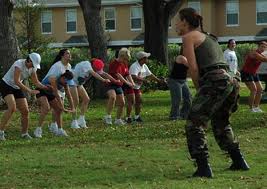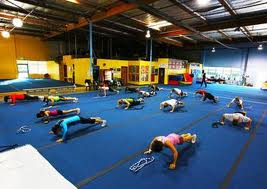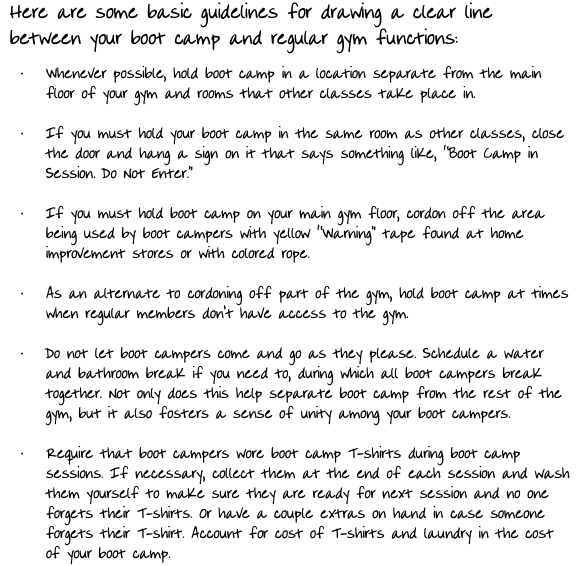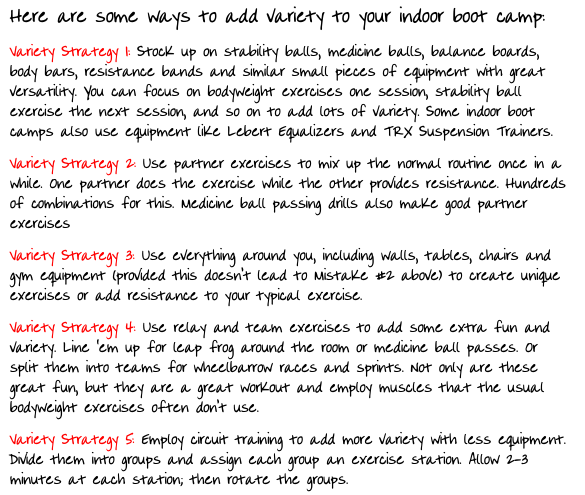 If you already own a gym or have access to gym facilities, it makes good sense to offer a fitness boot camp. A fitness boot camp provides a more personalized approach to fitness than the typical gym membership and provides a very different sort of work than aerobics, yoga, Pilates and other types of group fitness.
If you already own a gym or have access to gym facilities, it makes good sense to offer a fitness boot camp. A fitness boot camp provides a more personalized approach to fitness than the typical gym membership and provides a very different sort of work than aerobics, yoga, Pilates and other types of group fitness.
But running a boot camp in a gym has a unique variety of challenges. Let’s look at three common mistakes that gym owners make when launching a boot camp in their gym and how to avoid them . . .
 A properly run boot camp requires extra effort on your part than most other classes and gym programs. Your gym boot camp may also make use of additional equipment or pay fees for using parks or public spaces. Plus, boot camps should be an additional stream of revenue for you. For these reasons and probably some others, you should not include boot camps as part of your regular gym membership.
A properly run boot camp requires extra effort on your part than most other classes and gym programs. Your gym boot camp may also make use of additional equipment or pay fees for using parks or public spaces. Plus, boot camps should be an additional stream of revenue for you. For these reasons and probably some others, you should not include boot camps as part of your regular gym membership.
 Besides, including it as part of the gym memberships gives members the impression that they can show up and participate whenever they want to. Obviously, lack of commitment to your boot camp renders the program ineffective. You’ve designed your boot camp to get maximum results over a particular time period with a particular number of sessions in that time period. If a gym member misses half the sessions, they aren’t going to get the results you promised—boot campers have to be committed.
Besides, including it as part of the gym memberships gives members the impression that they can show up and participate whenever they want to. Obviously, lack of commitment to your boot camp renders the program ineffective. You’ve designed your boot camp to get maximum results over a particular time period with a particular number of sessions in that time period. If a gym member misses half the sessions, they aren’t going to get the results you promised—boot campers have to be committed.
The other side of this coin is not making it clear to members that boot camp requires fees in addition to their gym membership dues and why it is extra. This is taken care of simply by saying something on all your advertisements as simple as, “Regular cost is $150, Gym members pay only $100.” Just make sure the amount gym members pay isn’t the same as their membership dues so they can’t mistakenly think boot camp is part of the membership.
Some members may not understand why they have to pay extra for boot camp. To avoid this, make sure all your advertisements and flyers highlight the benefits of boot camp that don’t come with a standard gym membership—the personalized nutrition plans, the personal trainer-quality programming, guaranteed results, etc.

 The more your boot camp feels or looks like just another class of gym activity, the more members will expect it included as part of their membership. If your boot campers are using gym space or gym machines during the same hours that regular members are allowed to use them, then boot camp looks like a regular gym function. The same is true if boot campers are allowed to come and go whenever they want to during a session.
The more your boot camp feels or looks like just another class of gym activity, the more members will expect it included as part of their membership. If your boot campers are using gym space or gym machines during the same hours that regular members are allowed to use them, then boot camp looks like a regular gym function. The same is true if boot campers are allowed to come and go whenever they want to during a session.

 The temptation with indoor boot camps is to rely to heavily on the standard bodyweight exercises that don’t take up much space, such as push-ups, sit-ups, pull-ups, jumping jacks, mountain climbers, etc. These exercises allow you to keep everyone in a fairly tight group so you can use a smaller space than you would outdoors. Another temptation is to rely too much on the machines and equipment on your gym floor. Both scenarios can lead to a lack of variety in your boot camp program. Lack of variety reduces effectiveness of your program and bores your boot campers to tears.
The temptation with indoor boot camps is to rely to heavily on the standard bodyweight exercises that don’t take up much space, such as push-ups, sit-ups, pull-ups, jumping jacks, mountain climbers, etc. These exercises allow you to keep everyone in a fairly tight group so you can use a smaller space than you would outdoors. Another temptation is to rely too much on the machines and equipment on your gym floor. Both scenarios can lead to a lack of variety in your boot camp program. Lack of variety reduces effectiveness of your program and bores your boot campers to tears.
Using these techniques will make your boot camp stronger and help differentiate it from the usual gym activities, so you can successfully charge a fee that will be profitable for you.
Georgette Pann: owner of NutriFitness Personal Training Studio and Bootcamps. She is author and creator of the best selling “Sure VictoryFitness Bootcamp Kit”http://thefitnessbootcamp.com/ and Sure Results:The Ultimate Book of Bootcamp Workouts http://fitnessbootcampworkout.com


